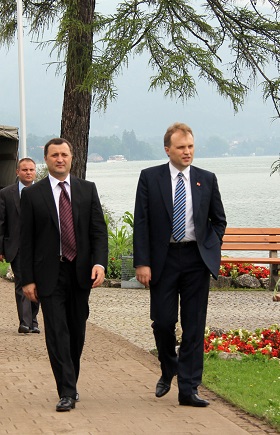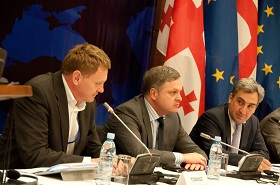Everyone knows how it feels to deal with a suitcase without a handle: you can’t carry it and you can’t drop it. In a way, this conveys the attitude toward Transnistria of most actors interested in settling this long-standing conflict, including the two sides (Chisinau and Tiraspol), mediators (Russia, Ukraine and the OSCE) and observers (the U.S. and the EU). Contemporary international politics presumes that “frozen” and similar ethno-territorial conflicts can be settled without delay. Everyone involved is supposed to pretend that this is a priority. But this abstraction has little to do with reality. The first and overriding concern of the leaders of the dominant political forces and parties to the conflict is to maintain the stability of their own positions of power and their current governments. External actors are pursuing their own geo-political and geo-economic interests, both genuine and fake. Since both Transnistria and Moldova, due to their small size and socio-economic underdevelopment, are of little value to these actors, only rivalry between the outsider players incentivizes conflict resolution.
Seasonal exacerbation?
At the insistence of the EU, in April 2013, the Moldovan authorities announced plans to establish six migratory posts on the administrative border with Transnistria to control the flow of foreigners coming into the country. These plans have raised concerns in Tiraspol, as they infringe on the rights of Transdniestrians with Russian passports (about 180,000) and Ukrainian passports (about 100,000) [1]. In response, on June 10 President of the Pridnestrovian Moldavian Republic (PMR) Yevgeny Shevchuk signed the Law on the State Border, in which the territory of the Republic, formally in line with its Constitution, includes a number of settlements under the control of Chisinau, namely, Varnita/Bender and several villages. The Moldovan and Transnistrian authorities have been reluctant to clarify how they are going to enforce these laws. Legal contradictions within them may cause border incidents and raise tensions [2]. But as long as the Russian peacekeeping mission on the Dniester River carries out its functions, the escalation of the conflict into is highly unlikely. This has been confirmed by the reaction of the authorities in Chisinau. The Declaration on the Current Situation of the Transnistrian Conflict Settlement Process adopted by Parliament on June 21, 2013 states that the government “will not allow the escalation of the situation and will ensure the overcoming of any dissensions through exclusively peaceful means.” The unwillingness of the PMR Supreme Soviet, which is in political opposition to the President, to follow Shevchuk’s recommendation to move to Bender speaks for itself too.
However, Chisinau and Tiraspol will be faced with an ultimate choice between uniting and separating fairly soon. The entry into force of agreements between Moldova and the EU on Association, on Deep and Comprehensive Free Trade Area and on Visa Liberalization will dramatically change the situation.
These agreements are likely to be initialed at the EU Eastern Partnership summit in Vilnius, Lithuania, in November 2013. In accordance with the agreements, the Moldovan authorities will induce the PMR population to become Moldovan citizens and Transnistrian economic entities, that is to follow new European standards. The PMR authorities have already declared their choice in favor of the Eurasian and the Customs Unions [3] as enshrined in their new foreign policy concept. As a result of such a development, territories on both banks of the Dniester River will be further isolated and the administrative border will be transformed into an interstate one. If the scenario of the forced “Europeanization” of Transnistria fails, the Moldovan authorities appear likely to accept its loss, provided they get a “go-ahead” from Brussels.
New developments and precedents arising from the situation in Kosovo lessen the chances of resolving the conflict. The current government of Serbia, aiming for the early negotiations on accession to the EU, has in fact not only recognized Kosovo, but also agreed to place its Serb-populated northern part under Pristina’s control. Belgrade still refuses to de jure recognize Kosovo’s independence. But the ease and swiftness with which the current Serb leaders, who were reputed nationalists and Russophiles, almost gratuitously ceded what they still had the chance to retain, testifies to their willingness to go to any length for admission to the EU.
There are indications that the Romanian Government, which has persisted in its unwillingness to recognize Kosovo’s independence, might change its position. It is noteworthy that Director of the Romanian Institute for Political Science and International Relations Dan Dungaciu called upon Moldova to cede Transnistria in exchange for European Integration, citing the Serbian example.
Russia’s Choice
The current situation, while opening up new opportunities for Russia, also raises new challenges for Moscow. In the short-term, Moldova's efforts to exert pressure on Transnistria by changing the migration and customs regimes will require Moscow to intensify its political and diplomatic counteractions with Chisinau and step up financial assistance to Transnistria to prevent its loss of sovereignty. Russia’s increased activity to these ends may prove to be insufficient. Currently, according to the Deputy Minister of Foreign Affairs of Transnistria Igor Shornikov, about 30 percent of the Transnistrian exports go to the EU. A little less goes to the other bank of the Dniester River.
Contrary to popular belief, in 2011 Russia accounted for 23.6 percent of the Transnistrian exports and 46.3 percent of its imports, which illustrates the scope of the required reorientation [4]. PMR (as well as Moldova) faces a serious chronic trade deficit. PMR debt on Russian gas has already reached 3.8 billion dollars and continues to grow. The planned budget deficit for 2012 was 68.6 percent, and the one of the Pension Fund – 45 percent, although pensioners make about 30 percent of the population. It’s easy to see that the economic viability of the PMR depends on the size of direct and indirect Russian aid.
When Moldova finally finds itself in the orbit of Brussels, Russia, like it or not, will be faced with the need to make a choice, as the traditional function of Transnistria to prevent Moldova from drifting towards Romania and/or the EU will lose its importance. Meanwhile, Transnistrian aspirations concerning the Customs Union are unlikely to be greeted with enthusiasm by all participants. Besides, their practical implementation is hardly probable without the consent of Ukraine, which may turn out to be quite problematic. It is reasonable to assume that Tiraspol will be ready to join Ukraine (such an option was probed in the early 1990s). But Kiev, playing its own deep game with Brussels and treating the issue of changing boundaries with extreme caution, is unlikely to welcome this “gift.”
Of course, one can see that the current government of Iurie Leancă, which was formed due to efforts by Brussels though with great difficulty, will not last long and the deep and comprehensive free trade area with the EU may deal the final blow to the Moldovan economy. We cannot rule out that new elections or a velvet revolution, promised by the Communist Party of Moldova in the fall, will return it to power. The Party now champions Eurasian integration. But the fine pre-election gestures of friendship with Moscow do not guarantee that it will not pursue a diametrically opposite policy after coming to power.
In Search for Partners
A change of government in Moldova is unlikely to entail any fundamental shifts either in the foreign policy orientation of the country, nor in the settlement of the Transnistrian conflict. The initial positions of Chisinau and Tiraspol are exactly the opposite. The Moldovan authorities, regardless of party affiliation, are willing to grant Transnistria autonomy at most, which is enshrined in the Law On the Basic Provisions of a Special Legal Status of Transnistria (July 22, 2005). The minimum which the Transnistrian authorities have reluctantly agreed to discuss if Moscow provided due incentives for Tiraspol, is a federation of two equal subjects with the possibility of granting independence if the status of the country changes. But in Chisinau, the leader of a small group of Socialists in Parliament (3 seats) Igor Dodon seems to be the only politician who has dared to mention the issue of such federation.
Only this option would allow Russia to maintain influence in the region, which makes it the only meaningful objective worth Moscow’s efforts. Such a federation would give strong institutional and international guarantees to Moldovan Communists, advocating “Moldovanism” (the existence of an independent Moldovan nation), against joining Romania, where they are sure to face not a gaudy lot. But the “eurodependence” and the common interests of the Moldovan elites, unwilling to share power with the elite of Transnistria, have not allowed the Party of Communists of the Republic of Moldova to take consistent positions, even in the pursuit of its own interests, when it was in power.
A similar political inconsistency is typical for the “unionists” who support unification with Romania. Mihai Ghimpu’s Liberal Party, now fractured and in opposition, champions unification most openly. But the parties of the ruling “pro-European” coalition and their leaders do not appear to be consistent defenders of the independent Moldovan state. The “Unionists” cannot but realize, and some of them directly admit, that Transnistria in any form is an obstacle to the desired union. Russia stands in the way, and any autonomy will be a rather dangerous precedent for the Romanian unitary state, which is currently fighting against autonomist aspirations of the Hungarian minority in Transylvania.
Claims on Transnistria devalue all theoretical arguments (international, legal, historical, and cultural) in favor of unification with the “brothers across the Prut.” True, Bucharest and Chisinau have been playing with the idea of “trading” Transnistria to Ukraine for South Bessarabia and Northern Bukovina [5]. It is not accidental that Romanian diplomats have persistently tried for many years to include in agreements with the Russian Federation and Ukraine a provision on the need to “eliminate the consequences of the Molotov-Ribbentrop Pact.” It is noteworthy that Romanian citizenship is being granted not only to the citizens of Moldova, but to the descendants of the pre-war residents of Bessarabia and Northern Bukovina, regardless of nationality.
One way or another, electoral considerations, the controversial recommendations of Bucharest, directives from Brussels and plain Russophobia are preventing Moldovan adherents of the “unity of the Romanians” form carrying out a clear-cut policy. Having succeeded in forming a “pro-European coalition”, Brussels has proved its ability to discipline its proponents who can hardly tolerate each other. To ensure its own reliable and responsible partners at the negotiation table, Moscow needs a reformatted Moldovan political scene. In any case, to stay in the game, Russia will have to redouble its efforts and articulate (both for itself and for the partners) its probable and desired results. The time has come to make a choice!
1. V. Demidetski. Pridnestrovskoe uregulirovanie: iz L'vova v Odessu // Kompas, # 11, March 7, 2013. p. 18
2. For details see: V. Demidetski . Kto delit Moldaviju po Dnestru? // Kompas, # 30, July 11, 2013. p. 24-26
3. Both PMR President E. Shevchuk (www.president.gospmr.ru/ru/news/vystuplenie-prezidenta-pmr-na-torzhestvennom-sobranii-posvyashchennom-22-y-godovshchine-so-dnya) and his opponent Chairman of the Supreme Soviet M. Burla keep confirming it.
4. The State Statistics Service of the Pridnestrovian Moldavian Republic. Statistical Yearbook, 2012. Tiraspol. p. 174. (www.mepmr.org/pechatnye-izdaniya/statisticheskij-ezhegodnik-pmr)
5. D.E. Furman Moldavskie moldavane i moldavskie rumyny. (Proceedings of the Institute of Europe. # 206). Moscow, Institute of Europe, Russian Academy of Sciences. 2007. pp. 35-36, 53-54.







